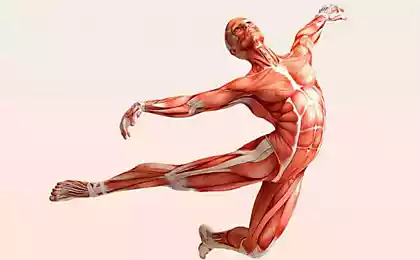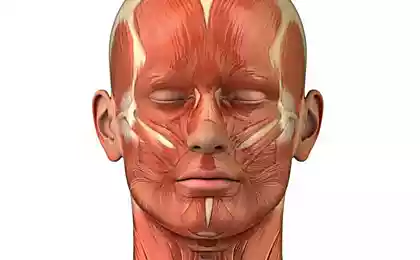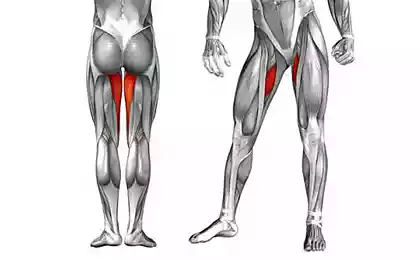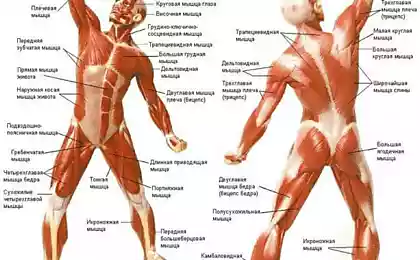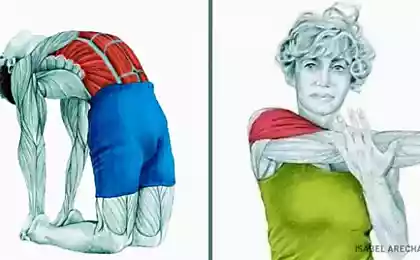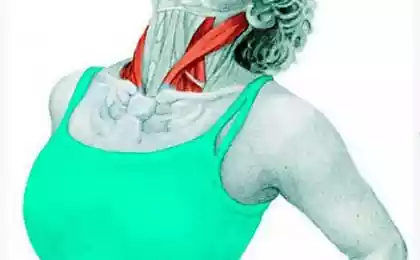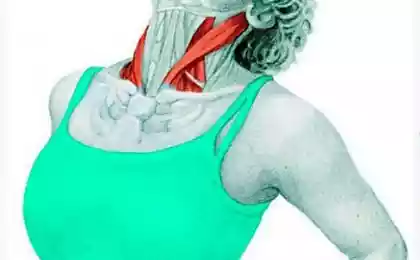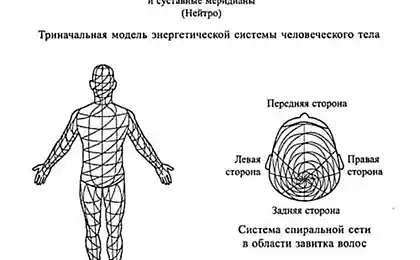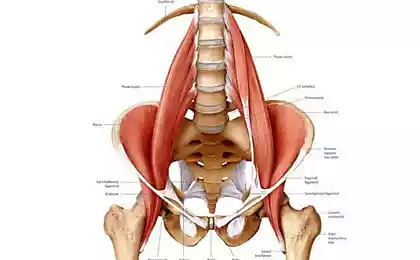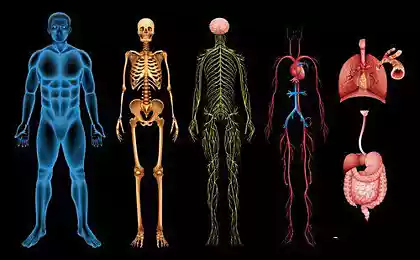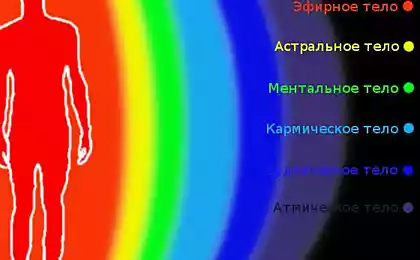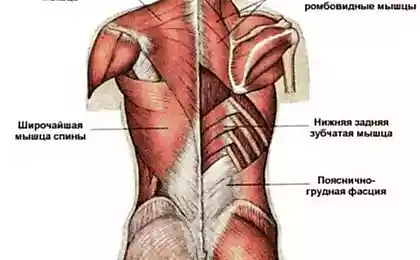654
8 key points that you NEED to know about fascia
1. Myofascia is a three – dimensional matrix
The fascia form a continuous three-dimensional matrix covering the whole body in General and operating support function to our organs, muscles, joints, bones and nerve fibers. In addition, a multi-dimensional arrangement of fascia and fascial varied orientation of the meridians allows us to move in different directions.
2. The fascia is a transmitter of forces
You ever seen how parkourist jumps with two - or three-story building, twisting and smoothly moves into a run? As their joints are not broken upon impact from the fall?
The answer lies in the fact that the internal force (muscle power) and external force (gravity and the reaction of the support) transmitted and spread through the body primarily via the fascial network (if only the forces are not exceeded).

Fascia help to prevent or minimize local stress in the area specific muscle, joint or bone, and use the energy-momentum created under the action of forces, due to its viscoelastic properties. This ensures the integrity of the body with minimal energy consumption required to execute movements.
Muscle-fascial meridians, as described in the "Anatomical trains", give us a clearer idea of exactly how the fascia softens tension and power throughout the body, depending on the direction of the applied force.
3. The benefits and harms of repetitions
According to the law of Davis, the soft tissues that make up the fascia, can become (harder and denser) along the special fascial lines (Clark, Lucett & Corn 2008).
It can bring a temporary advantage, and long-term side effects. At repeated repetition of certain movements soft tissues into the direction of the movement and becomes stronger and more stable against forces acting in a given direction.
The constant repetition of the same movements can strengthen the fascia along lines of tension, but weaken it in other areas, which can lead to more frequent tearing of the fascia or the immobility of adjacent joints when moving in different directions. The same applies to the prolonged absence of movement, for example, for long-term sitting or standing, repetitive days, months and years.

4. Fascia can heal or hypertrophy
A 1995 study showed that mechanical stress (exercise) can lead to hypertrophy of the ligaments, forming the fascia (Fukuyama et al. 1995). New scientific research demonstrate the ability of the fascial system to repair itself after breaks.
Data from such research have shown that some of the victims with fractures of the anterior cruciate ligament (ACL) were able to fully restore its function without surgery and that the torn ligament is fully healed (Matias et al. 2011). Further exploration leads to the development of new rehabilitation techniques and new approaches to physical training.
5. Fascia can be reduced
The fascia was discovered myofibroblast, able to reductions, such as those that occur in smooth muscle (Schleip et al. 2005). In addition, the fascial matrix has found numerous mechanoreceptors (tendon organs Golgi, Ruffini endings, Pacini corpuscles).
These receptors are also involved in contractions of the fascia, like smooth muscle, and Central nervous system (Myers 2011). There is an assumption that reductions fascia provides balance and uniform energy consumption. To understand how koordiniruyutsya reduction of fascia and muscle, as these cuts affect the movement of the body as a whole and what value do they have for fitness, more research is needed.
6. Fascia can act independently from the Central nervous system
Because of the action of gravity, the fascia are always in a state of stress. This passive pre-tension has been called myofascial tone at rest (human resting myofascial tone), for description of which Myers uses the principle of "Tensegrity" (Alfonse et al. 2010; Myers 2001). Muscular and fascial tonus of peace is a stabilizing element that keeps our body in a certain position and allows us to make different movements (e.g., sit down and get out of the car) automatically, without thinking about them.
Because the connective tissue contains 10 times more proprioceptorov are than in the muscle (Myers 2011), the fascial matrix helps us react to the environment faster than our consciousness (whether we stumbled on the step, respond to the actions of the player from the opposing team or otdeleniem the hand from a hot stove).
Additionally, this pre-stress, we are less tired and do not overextend fascia, supporting the position of the body, than if our muscles is constantly decreasing and consuming energy. I am reminded of a story one of my client, as she stood at the stove for 8 hours without back pain that prior to the training was for her an impossible task. Perhaps the exercise helped her strengthen Tensegrity and enhance pre-stressing of the fascia?
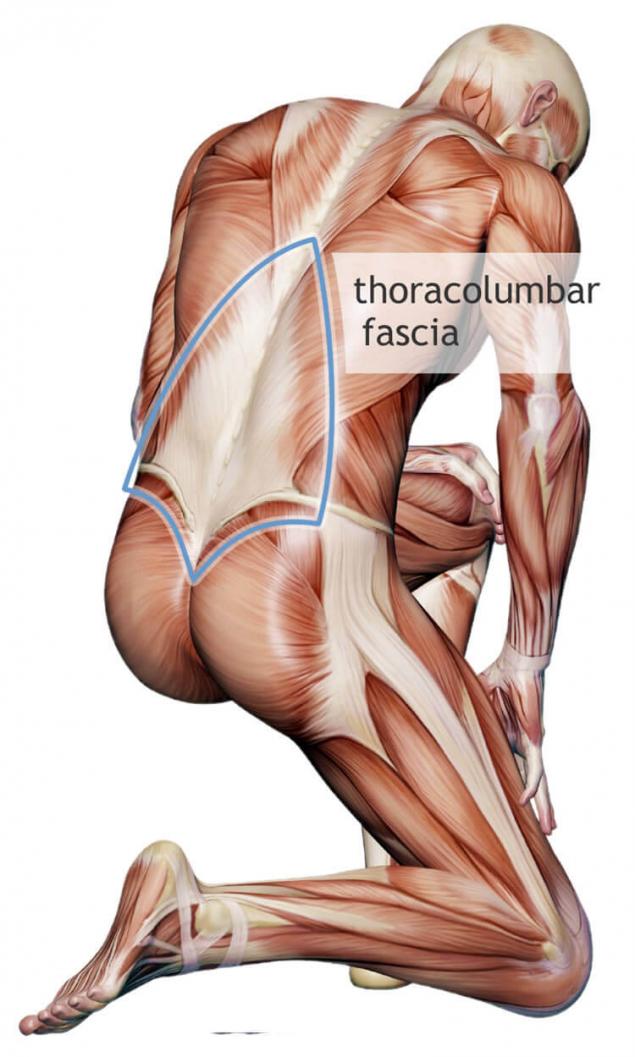
7. The condition of the fascia depends on the mood
In his book "the Endless web: fascial anatomy and physical reality" (The Endless Web: Fascial Anatomy and Physical Reality) (North Atlantic 1996) R. Louis Shultz (R. Louis Shultz) and rosemary Feitis (Rosemary Feitis) talks about how our emotions are stored in the body, including in connective tissue.
"Physical response to emotion is through the soft tissues," write the authors. "The fascia is the emotional body. Theoretically, feelings are felt with the whole body, because emotions are transmitted through the fascial network. Then we can identify physiological sensations as anger, tenderness, love, interest, and so on. Perhaps you are unable to straighten and stretch your neck because you were abused as a child. Physical work could only partly be cause of the problem. We must not forget that the main reason may lie in the emotions."
This idea gives fitness instructors the key to holistic understanding of body position and movements, considering them not only with physical but also with emotional and psychological point of view. Fascia can become more rigid and less elastic, if the person is prone to depression, anxiety or fear (Shultz & Feitis 1996; Lowe 1989).
It's easy to see when a client comes for a workout after a hard day emotionally. Mood significantly affects the posture, movement and proprioception. It is likely that through the fascial network is in a good mood can improve.
8. With the help of the fascia is possible to train the body as a whole
As we know from the work of Myers, as a result of preparirovanie it became known that connective tissue not only acts as a sheath of muscles, bones and organs, but also passes through many layers (Myers 2001). Such a connection connects our movements and functions into a single unit. Both athletes and those who simply want to improve your fitness, should know how important it is to include in their training exercises for the entire body. The key to understanding this aspect lies in the understanding of the fascial network.
Fascia — the "secret" on your bodydo Not allow lymph to stagnate!The more we learn about connective tissue, the better we understand its relationship with other body systems (muscular, nervous, skeletal systems) and obtain better understanding about the movement of the human body and the possibilities of our body as a whole. Applying knowledge of myofascial lines exercise can effectively alleviate the impact force, to save energy costs and to develop endurance, while increasing mobility and strength of all joints.published
Thomas Myers "Anatomy trains"
Louis Schultz, rosemary Feitis "the Endless web: fascial anatomy and physical reality"
Source: vk.com/wall-23903469?w=wall-23903469_8939
The fascia form a continuous three-dimensional matrix covering the whole body in General and operating support function to our organs, muscles, joints, bones and nerve fibers. In addition, a multi-dimensional arrangement of fascia and fascial varied orientation of the meridians allows us to move in different directions.
2. The fascia is a transmitter of forces
You ever seen how parkourist jumps with two - or three-story building, twisting and smoothly moves into a run? As their joints are not broken upon impact from the fall?
The answer lies in the fact that the internal force (muscle power) and external force (gravity and the reaction of the support) transmitted and spread through the body primarily via the fascial network (if only the forces are not exceeded).

Fascia help to prevent or minimize local stress in the area specific muscle, joint or bone, and use the energy-momentum created under the action of forces, due to its viscoelastic properties. This ensures the integrity of the body with minimal energy consumption required to execute movements.
Muscle-fascial meridians, as described in the "Anatomical trains", give us a clearer idea of exactly how the fascia softens tension and power throughout the body, depending on the direction of the applied force.
3. The benefits and harms of repetitions
According to the law of Davis, the soft tissues that make up the fascia, can become (harder and denser) along the special fascial lines (Clark, Lucett & Corn 2008).
It can bring a temporary advantage, and long-term side effects. At repeated repetition of certain movements soft tissues into the direction of the movement and becomes stronger and more stable against forces acting in a given direction.
The constant repetition of the same movements can strengthen the fascia along lines of tension, but weaken it in other areas, which can lead to more frequent tearing of the fascia or the immobility of adjacent joints when moving in different directions. The same applies to the prolonged absence of movement, for example, for long-term sitting or standing, repetitive days, months and years.

4. Fascia can heal or hypertrophy
A 1995 study showed that mechanical stress (exercise) can lead to hypertrophy of the ligaments, forming the fascia (Fukuyama et al. 1995). New scientific research demonstrate the ability of the fascial system to repair itself after breaks.
Data from such research have shown that some of the victims with fractures of the anterior cruciate ligament (ACL) were able to fully restore its function without surgery and that the torn ligament is fully healed (Matias et al. 2011). Further exploration leads to the development of new rehabilitation techniques and new approaches to physical training.
5. Fascia can be reduced
The fascia was discovered myofibroblast, able to reductions, such as those that occur in smooth muscle (Schleip et al. 2005). In addition, the fascial matrix has found numerous mechanoreceptors (tendon organs Golgi, Ruffini endings, Pacini corpuscles).
These receptors are also involved in contractions of the fascia, like smooth muscle, and Central nervous system (Myers 2011). There is an assumption that reductions fascia provides balance and uniform energy consumption. To understand how koordiniruyutsya reduction of fascia and muscle, as these cuts affect the movement of the body as a whole and what value do they have for fitness, more research is needed.
6. Fascia can act independently from the Central nervous system
Because of the action of gravity, the fascia are always in a state of stress. This passive pre-tension has been called myofascial tone at rest (human resting myofascial tone), for description of which Myers uses the principle of "Tensegrity" (Alfonse et al. 2010; Myers 2001). Muscular and fascial tonus of peace is a stabilizing element that keeps our body in a certain position and allows us to make different movements (e.g., sit down and get out of the car) automatically, without thinking about them.
Because the connective tissue contains 10 times more proprioceptorov are than in the muscle (Myers 2011), the fascial matrix helps us react to the environment faster than our consciousness (whether we stumbled on the step, respond to the actions of the player from the opposing team or otdeleniem the hand from a hot stove).
Additionally, this pre-stress, we are less tired and do not overextend fascia, supporting the position of the body, than if our muscles is constantly decreasing and consuming energy. I am reminded of a story one of my client, as she stood at the stove for 8 hours without back pain that prior to the training was for her an impossible task. Perhaps the exercise helped her strengthen Tensegrity and enhance pre-stressing of the fascia?

7. The condition of the fascia depends on the mood
In his book "the Endless web: fascial anatomy and physical reality" (The Endless Web: Fascial Anatomy and Physical Reality) (North Atlantic 1996) R. Louis Shultz (R. Louis Shultz) and rosemary Feitis (Rosemary Feitis) talks about how our emotions are stored in the body, including in connective tissue.
"Physical response to emotion is through the soft tissues," write the authors. "The fascia is the emotional body. Theoretically, feelings are felt with the whole body, because emotions are transmitted through the fascial network. Then we can identify physiological sensations as anger, tenderness, love, interest, and so on. Perhaps you are unable to straighten and stretch your neck because you were abused as a child. Physical work could only partly be cause of the problem. We must not forget that the main reason may lie in the emotions."
This idea gives fitness instructors the key to holistic understanding of body position and movements, considering them not only with physical but also with emotional and psychological point of view. Fascia can become more rigid and less elastic, if the person is prone to depression, anxiety or fear (Shultz & Feitis 1996; Lowe 1989).
It's easy to see when a client comes for a workout after a hard day emotionally. Mood significantly affects the posture, movement and proprioception. It is likely that through the fascial network is in a good mood can improve.
8. With the help of the fascia is possible to train the body as a whole
As we know from the work of Myers, as a result of preparirovanie it became known that connective tissue not only acts as a sheath of muscles, bones and organs, but also passes through many layers (Myers 2001). Such a connection connects our movements and functions into a single unit. Both athletes and those who simply want to improve your fitness, should know how important it is to include in their training exercises for the entire body. The key to understanding this aspect lies in the understanding of the fascial network.
Fascia — the "secret" on your bodydo Not allow lymph to stagnate!The more we learn about connective tissue, the better we understand its relationship with other body systems (muscular, nervous, skeletal systems) and obtain better understanding about the movement of the human body and the possibilities of our body as a whole. Applying knowledge of myofascial lines exercise can effectively alleviate the impact force, to save energy costs and to develop endurance, while increasing mobility and strength of all joints.published
Thomas Myers "Anatomy trains"
Louis Schultz, rosemary Feitis "the Endless web: fascial anatomy and physical reality"
Source: vk.com/wall-23903469?w=wall-23903469_8939
